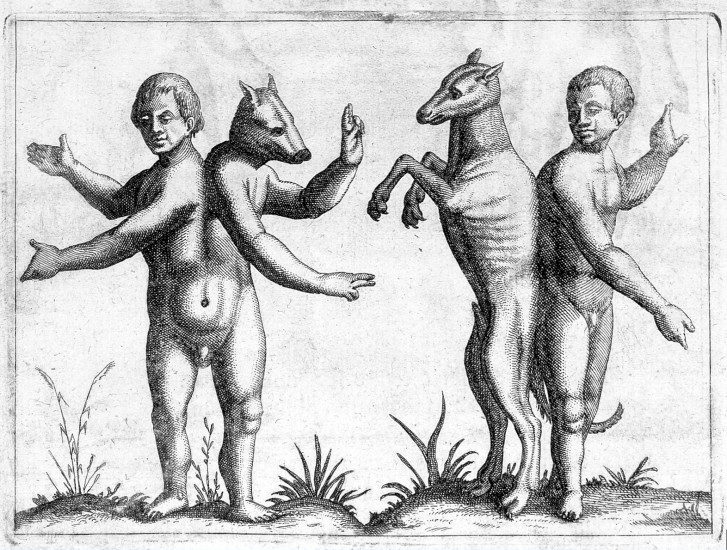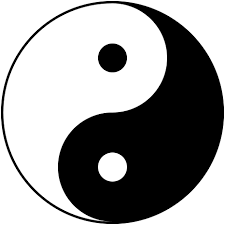
Birthing polarity: When one becomes two
Light is meaningful only in relation to darkness.
—Louis Aragon
The goddess Ceridwen has two children. One bears the face of the most beautiful maiden in the world. The other, misshapen, becomes known for his unparalleled hideousness.
The goddess Arianrhod steps over a magic wand and gives birth to twins. One emerges from her womb perfectly formed and takes to the sea, spending his life beneath the waves. The other, a mere blob, is nearly overlooked but eventually grows up to claim his birthright as a sun god.
Light and dark. Life and death. Order and chaos. Love and fear. Self and other.
As humans, we inhabit a world divided in two. Two genders. Two hemispheres in our brains. Two divine forces—good and evil—that clash endlessly with each other. The very atoms from which we’re made are composed of both positive and negative particles.
 According to Hermetic wisdom, “all manifested things have two sides, two aspects, two poles.” This dual nature is reflected in mythologies the world over, which are peppered with examples of twin deities existing as pairs of opposites. In Zoroastrian mythology, the twins Ahriman and Ahura Mazda represent the spirits of evil and good. An Egyptian creation myth pairs the earth god Geb and the sky goddess Nut together as twins.
According to Hermetic wisdom, “all manifested things have two sides, two aspects, two poles.” This dual nature is reflected in mythologies the world over, which are peppered with examples of twin deities existing as pairs of opposites. In Zoroastrian mythology, the twins Ahriman and Ahura Mazda represent the spirits of evil and good. An Egyptian creation myth pairs the earth god Geb and the sky goddess Nut together as twins.
In Y Mabinogi we find two powerful creator-goddesses, Ceridwen and Arianrhod, who give birth to children with opposing characteristics, each pair representing one of the most basic and fundamental dichotomies: dark and light. In both cases, the duality of their offspring receives only a brief mention within a much larger tale, yet these few lines speak volumes about the nature of human consciousness—and how we can develop its potential.
In Arianrhod’s tale, we see the duality of human consciousness revealed. Llew, the child who becomes a sun god, represents the conscious mind, which encompasses those aspects of reality on which we shine the light of awareness. Dylan, the child who takes to the sea, represents the dark waters of the unconscious. This duality is reinforced by the narrative structure itself. After a brief initial scene describing their birth, the spotlight remains firmly upon Llew’s exploits for the duration of the tale, while Dylan is never mention again. Like the unconscious, his life remains as mysterious and hidden from view as the ocean’s depths.
As the divine embodiment of light and dark, Llew and Dylan represent not just the conscious and unconscious self, but the divine presence within each of them, says Jhenah Telyndru, a scholar of Celtic myth. She notes that it is the child of the sea, “the sense of Divinity immersed in the unconscious of us all,” who is born whole, while the sun child is not yet fully formed, “signifying our need to develop the consciousness of our Divinity which, once complete, will make our souls shine like the sun.”
In Ceridwen’s children, we again see a correlation to the light and shadow selves within each of us. Her beautiful daughter stands for all of the qualities we’re willing to see and embrace within ourselves—the aspects of ourselves we allow into the light of consciousness. The ugliness of her son Afagddu (which means “utter darkness”) represents all of the things within us that we despise, repress and refuse to look at. These we keep submerged in the depths of our unconscious, where they remain forgotten but not gone, coalescing into our unseen but potent shadow.
Yet despite his ugliness, Ceridwen doesn’t despise her son. She resolves to “boil a cauldron of Inspiration and Science” to give him “some exalted merits or knowledge” with which to gain acceptance among men of noble birth. She teaches us that by accessing the gifts of wisdom and inspiration within our shadow selves, we can transform the darkness and bring it into the light of acceptance.
Only by uniting the opposites—bringing light to the darkness and the darkness into light—can we unlock our creative gifts and realize the wholeness of the divinity within each of us.
The lesson these two goddesses offer can serve as a roadmap for moving from the dividing concept of duality to the uniting of principle of polarity.
The dualistic perspective splits the world into pairs of opposites that are in constant conflict with each other. One is considered desirable, while the other must be eradicated or subdued. Good must overcome evil. Life must overcome death. Yet one cannot exist without the other, leaving two are eternally locked in perpetual battle. This leaves human beings, whose internal dual nature is inescapable, at constant war not only with the “other,” but also with ourselves.
The one concept that above all others plagues human beings, and has done so for all of recorded history, is the concept of duality. It is a hidden enemy, created in wrong thought (relative consciousness), and fed by fear. It has divided the world of man and has been the instrument of more death and destruction than all the terms we commonly use to describe evil.
According to the Hermetic principle of polarity, however, each pair of opposites exists on either end of a spectrum, with “manifold degrees between the two extremes.” It is in the tension between them that the creative power of the universe resides. As psychologist C. G. Jung states, “Nothing can exist without its opposite; the two were one in the beginning and will be one again in the end.” To eradicate one would be to destroy both—and with them, all of creation.
What does that mean for the two sides of human consciousness? It means the darkness within us cannot be conquered or eliminated; it can only be brought into the light. It means we cannot rely only on our semi-formed consciousness to guide us; we need the wholeness of divinity within our unconscious. It means the more we unite our inner opposites, the more whole we become—and the more potent we are as creators.
“It is these mingled opposites which people our life, which make it pungent, intoxicating,” says French poet Louis Aragon. “We only exist in terms of this conflict, in the zone where black and white clash.”
Disowning any part of ourselves, or ignoring what we cannot see, only leaves us in a state of inner warfare. The dark twin has more to offer than we can possibly imagine, if only we would pay attention.
Featured image via Wellcome Library